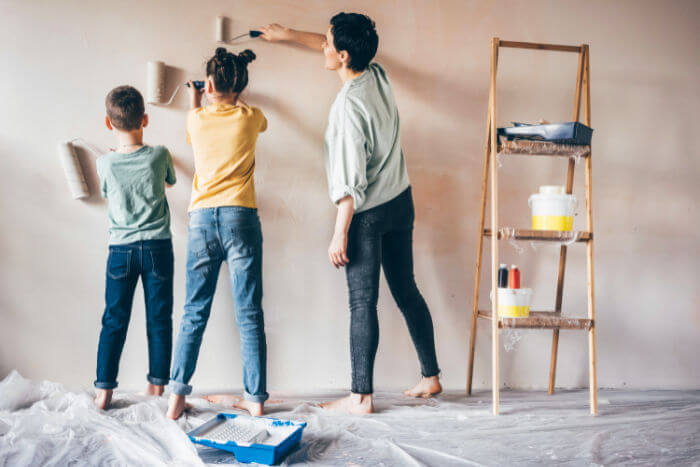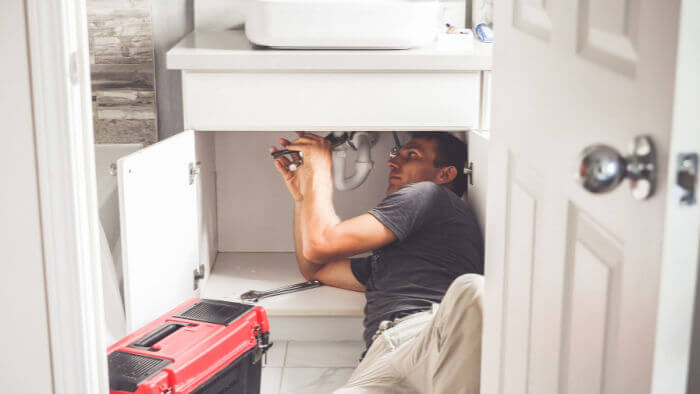Are you doing a home improvement project?
Modernize can pair you with three to four pros in your area, so you can compare options and save time and money.
When it comes to do-it-yourself projects around the house, homeowners’ handiness levels run the full spectrum. Some homeowners are highly skilled in DIY home projects, while others are total beginners.
Nonetheless, most of us can easily tackle simple DIY projects such as touching up scuffed baseboards or applying new caulking around the shower and tub. Truly skilled homeowners, meanwhile, are competent in their ability to install a new tile shower or replace rotted redwood decking with a paver patio complete with a built-in barbecue and other fancy accessories.
Modernize created this DIY guide for home projects to provide homeowners with a sense of which jobs are possible vs. those they should never consider undertaking.
Why is DIY Sometimes a Bad Idea?
Regardless of your personal renovation and DIY skill levels, there are some jobs even the craftiest homeowners should leave to trained professionals. DIY disasters include electrical mistakes, flooding and water damage, and even hurting yourself in the process. Another huge issue with DIY is unexpected problems that arise only after starting the project.
For example, discovering a plumbing leak or rotting subflooring after demolition can be dangerous and require immediate professional help. The cost to repair these damages once the project is already underway can far outweigh the cost of hiring a professional in the first place.
In fact, many home improvement projects completed by an experienced contractor result in a higher return on investment compared to projects done by homeowners. According to NerdWallet, homeowners attempting DIY home improvement projects are still the minority, even since Covid-19. As of 2020, 37% of homeowners attempted DIY projects while 63% of projects were left to the professionals. This goes to show that even during a global pandemic, there are still downsides to attempting DIY on larger home projects.
All in all, if you are at all uncertain in your know-how to complete a certain DIY project, your best bet is to work with an experienced professional.
Top 5 DIY Home Projects
Many homeowners have the skill set to complete small, easy DIY renovation projects. Here’s a list of five DIY projects most homeowners should be able to handle on their own (as long as you know the fundamentals of completing DIY home projects).
1. Installing cabinet hardware
New hardware fixtures can transform the aesthetics and functionality of your kitchen or bathroom cabinetry. Knobs are simple to replace, but installing new knobs or pull handles requires a bit more measuring precision. You will want to make sure you drill holes in the exact same place on each cabinet face panel. Like nearly all finish work, there is zero margin for error. Measure thrice, drill once. If you are questioning your know-how with measurements, it is safer to use a contractor.
2. Installing shelving and storage space
There’s no such thing as too much storage or knick-knack space. Installing premade shelving is a great DIY home project to increase storage and functionality in any space. For instance, DIY bathroom storage ideas include floating shelves or cubbies. Installing storage should be a straightforward task for anyone comfortable using a tape measure and cordless drill.

3. Re-caulking gaps
Caulking often shrinks and leaves gaps after application. Some caulking, like on the top of baseboards, is purely cosmetic. Other uses, such as the caulking around sinks, tubs, toilets, as well as on exterior trim and around windows, are highly functional. The caulking is there to reduce water damage.
Be aware that resealing can be a messy job for beginners. Start by cutting a small hole in the tip of the caulking tube to constrict its flow. You can always make it bigger if you need a larger bead.
4. Adding roll-outs to kitchen shelving
Tired of trying to dig into the back of your kitchen cabinets for a lost lid? Installing rollouts will allow you to slide the shelf out and easily access all those formerly tucked-away items. Rollouts are easy to mount, but make sure you’ve ordered the proper sizes.
5. Painting interior walls
Painting interior walls is a DIY task truly takes very little skill. However, there is a big disparity between most people’s painting skills and those of professional house painters. Any able-bodied person can spread paint on a wall using rollers. It takes a steady, experienced hand to professionally cut in paint at corners where two different colors meet, or around trim, shutters and other fixtures, as anyone who has ever repainted their home can attest.

Find the Right Contractor for Your Project
Whether you’re ready to begin your project now or need some expert advice, our network of contractors are here to help. With a few simple questions, we’ll find the best local professionals for you
If you are feeling up for the challenge, keep in mind that you can paint more than just your home’s walls. Other DIY painting projects include painting cabinets, garage doors, and even older vinyl flooring.
Top 5 Home Projects Best Left to the Professionals
Unless you have an extensive background working in the construction trades, you should probably pass on undertaking these five DIY home projects. Delegating the project to a professional contractor reduces your risk of unsatisfactory work, as well as wasting valuable time and money.
1. Upgrading your windows
New windows are an excellent way to improve your home’s insulation value and boost energy efficiency. Replacing windows on a residence clad in siding is not terribly difficult for a homeowner with basic carpentry skills. You can just pull all the nails in the window trim and surrounding siding to expose the window flange for removal.

Things are far more complicated on structures clad in stucco, however. For starters, you’ll need to cut the stucco back to expose the window. All in all, window replacements are definitely best left to the professionals. Calculate the cost of a potential window project for your home using our windows cost calculator.
2. Installing a paver patio or retaining wall
Pavers are not terribly difficult, in theory. You take a completely flat grade, compact some base rock and sand, and start laying them on top. While many homeowners can tackle this one, the work can prove quite challenging. Pavers and related hardscape materials, such as retaining wall blocks, are very heavy. They often require a great deal of saw-cutting. This is a DIY project that is hard to perfect. But for a landscaping contractor, perfection is second nature.
3. Removing trees
Owning a chainsaw does not make you a tree feller. Stick to removing smaller limbs and cutting back overgrowth. Leave large tree removal projects to the trained professionals who have the skills and equipment to get the job done safely. This is especially important for taller trees – height greatly increases risk factors.
4. Major electrical work and plumbing

Many homeowners have the chops to change a standard plug outlet into a USB smart outlet. It is really just a matter of connecting a few wires. Things get much more complicated when you are dealing with wiring a new addition or changing the fixture and plug layout in your bathroom or kitchen remodel. Hire a licensed electrician, and you will sleep soundly knowing the job was completed correctly.
The same goes for plumbing. Installing a fancy new faucet or replacing the backflow preventer on your sprinkler system are not particularly challenging DIY projects. Replacing a rotted-out sewer line and other major plumbing work, however, should only be done by a licensed plumbing shop.
5. Removing and replacing siding
It may be tempting to try to remove your house’s siding on your own to save some money. But doing this on your own can be very risky. Attempting a DIY siding removal can result in irreparable or extremely costly damage to your home. Not to mention, it’s possible to find rotting or other structural damage that needs professional attention while removing.
Leaving a siding removal and replacement to a professional contractor is not only safer, but much more time effective. Many homeowners actually reduce costs by using a professional and avoid poor quality siding replacements. Calculate about how much it will cost to complete a siding replacement project using a professional with our siding cost calculator.
DIY vs. Professional Home Projects: The Bottom Line
Wielding a hammer or paint brush often brings homeowners the same sense of satisfaction and accomplishment that craft and tradespeople routinely enjoy.
When considering DIY projects, it is important to know your strengths and limitations. Bungling a paint project in your daughter’s bedroom does not have the same long-term ramifications as installing faulty electrical wiring or plumbing. Haphazardly completed projects can lead to building code violations if your home has an inspection prior to a sale.
Play to your DIY strengths, and do not be hesitant about hiring contractors when needed.
Find the Right Contractor for Your Project
Whether you’re ready to begin your project now or need some expert advice, our network of contractors are here to help. With a few simple questions, we’ll find the best local professionals for you
Reviews from Real Homeowners
Welcome to Homeowner Resources! We are the Modernize blog. Modernize pairs more than 3 million homeowners a year with pre-vetted contractors in their area. This blog started because we believe homeowners should know everything about their homes, from how their HVAC works to which front door colors they might love. On Homeowner Resources, you can find information on every part of your home, right down to how you can negotiate with contractors to get the best price. Here's more about the blog.
Need a contractor? Learn more about how Modernize finds the right pro for you.




